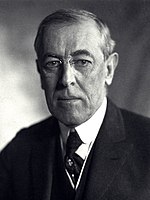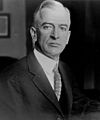
A | B | C | D | E | F | G | H | CH | I | J | K | L | M | N | O | P | Q | R | S | T | U | V | W | X | Y | Z | 0 | 1 | 2 | 3 | 4 | 5 | 6 | 7 | 8 | 9
| |||||||||||||||||||||||||||||
531 members of the Electoral College 266 electoral votes needed to win | |||||||||||||||||||||||||||||
|---|---|---|---|---|---|---|---|---|---|---|---|---|---|---|---|---|---|---|---|---|---|---|---|---|---|---|---|---|---|
| Turnout | 49.2%[1] | ||||||||||||||||||||||||||||
| |||||||||||||||||||||||||||||
 Presidential election results map. Red denotes states won by Harding/Coolidge, blue denotes those won by Cox/Roosevelt. Numbers indicate the number of electoral votes allotted to each state. | |||||||||||||||||||||||||||||
| |||||||||||||||||||||||||||||

The 1920 United States presidential election was the 34th quadrennial presidential election, held on Tuesday, November 2, 1920. In the first election held after the end of the First World War and the first election after the ratification of the Nineteenth Amendment (which gave equal votes to men and women), Republican Senator Warren G. Harding of Ohio defeated Democratic Governor James M. Cox of Ohio. It was also the third presidential election in which both major party candidates were registered in the same home state; the others have been in 1860, 1904, 1940, 1944, and 2016.
Incumbent Democratic President Woodrow Wilson privately hoped for a third term, despite his severe physical and mental disabilities. He had very little support. Former President Theodore Roosevelt had been the front-runner for the Republican nomination, but he died in 1919 without leaving an obvious heir to his progressive legacy. The major parties turned to little-known dark horse candidates from the state of Ohio, a swing state with a large number of electoral votes. Cox won on the 44th ballot at the 1920 Democratic National Convention, defeating William Gibbs McAdoo (Wilson's son-in-law), A. Mitchell Palmer, and several other candidates. Harding emerged as a compromise candidate between the conservative and progressive wings of the party, and he clinched his nomination on the tenth ballot at the 1920 Republican National Convention.
The election was dominated by the American social and political environment in the aftermath of World War I, which was marked by a hostile response to certain aspects of Wilson's foreign policy and a massive reaction against the reformist zeal of the Progressive Era. The wartime economic boom had collapsed and the country was deep in a recession. Wilson's advocacy for America's entry into the League of Nations in the face of a return to non-interventionist opinion challenged his effectiveness as president, and overseas there were wars and revolutions. At home, the year 1919 was marked by major strikes in the meatpacking and steel industries, and large-scale race riots in Chicago and other cities. Anarchist attacks on Wall Street produced fears of radicals and terrorists. The Irish Catholic and German communities were outraged at Wilson's perceived support of their traditional enemy Great Britain, and his political position was critically weakened after he suffered a stroke in 1919 that left him severely disabled.
Harding all but ignored Cox in the race, and essentially campaigned against Wilson by calling for a "return to normalcy". Harding won a landslide victory, sweeping every state outside of the South and becoming the first Republican since the end of Reconstruction to win a former state of the Confederacy, Tennessee. Harding's victory margin of 26.2% in the popular vote remains the largest popular-vote percentage margin for a Republican and the largest ever since widespread popular elections began in the 1820s, although subsequent candidates (in 1936, 1964 and 1972) have exceeded his share of the popular vote.[2] Cox won just 34.1% of the popular vote, and Socialist Eugene V. Debs won 3.4%, despite being in prison at the time. It was also the first election in which women had the right to vote in all 48 states, which caused the total popular vote to increase dramatically, from 18.5 million in 1916 to 26.8 million in 1920.[3] Both major-party vice-presidential nominees would later succeed to the presidency: Calvin Coolidge (Republican) upon Harding's death in 1923 and Franklin D. Roosevelt (Democratic) after defeating Republican President Herbert Hoover in 1932.
Nominations
Republican Party nomination
 | |||||||||||||||||||||||||||||
| Warren G. Harding | Calvin Coolidge | ||||||||||||||||||||||||||||
|---|---|---|---|---|---|---|---|---|---|---|---|---|---|---|---|---|---|---|---|---|---|---|---|---|---|---|---|---|---|
| for President | for Vice President | ||||||||||||||||||||||||||||
 |
 | ||||||||||||||||||||||||||||
| U.S. Senator from Ohio (1915–1921) |
48th Governor of Massachusetts (1919–1921) | ||||||||||||||||||||||||||||
| ID: 39 votes[4] HCV: 692.2 votes 144,762 votes | |||||||||||||||||||||||||||||
Other Candidates
| Candidates in this section are sorted by their highest vote count on the nominating ballots | ||||||
| Leonard Wood | Frank Orren Lowden | Hiram Johnson | William Cameron Sproul | Nicholas Murray Butler | Calvin Coolidge | |
|---|---|---|---|---|---|---|
 |
 |
 |
 |
 |
 | |
| Chief of Staff of the Army from New Hampshire (1910–1914) |
Governor of Illinois (1917–1921) |
U.S. Senator from California (1917–1945) |
Governor of Pennsylvania (1919–1923) |
Columbia University President from New York (1902–1945) |
Governor of Massachusetts (1919–1921) | |
| ID: 145 votes[4] HCV: 314.5 votes 710,863 votes |
ID: 78 votes[4] HCV: 311.5 votes 389,127 votes |
ID: 110 votes[4] HCV: 148 votes 965,651 votes |
ID: 0 votes[4] HCV: 84 votes 0 votes |
ID: 0 votes[4] HCV: 69.5 votes 0 votes |
ID: 0 votes[4] HCV: 34 votes 0 votes | |
| Robert M. La Follette | Jeter Pritchard | Miles Poindexter | Howard Sutherland | Herbert Hoover | ||
 |
 |
 |
 |
 | ||
| U.S. Senator from Wisconsin (1906–1925) |
Court of Appeals Judge from North Carolina (1904–1921) |
U.S. Senator from Washington (1911–1923) |
U.S. Senator from West Virginia (1917–1923) |
Director of the U.S. Food Administration from California (1917–1918) | ||
| ID: 0 votes[4] NFN HCV: 24 votes 0 votes |
ID: 17 votes[4] HCV: 21 votes 0 votes |
ID: 14 votes[4] HCV: 20 votes 3,806 votes |
ID: 0 votes[4] HCV: 17 votes 33,849 votes |
ID: 0 votes[4] HCV: 10.5 votes 303,815 votes | ||
Following the return of former president Theodore Roosevelt to the Republican Party after the previous election, speculation quickly grew as to whether he would make another run for the presidency. Roosevelt's health declined seriously in 1918, however, and he died on January 6, 1919. Attention then turned to the party's unsuccessful 1916 candidate, Charles Evans Hughes, who had narrowly fallen short of defeating Wilson that year, but Hughes remained aloof as to the prospect of another run, and ultimately ruled himself out following the death of his daughter early in 1920.
On June 8, the Republican National Convention met in Chicago. The race was wide open, and soon the convention deadlocked between Major General Leonard Wood and Governor Frank Orren Lowden of Illinois.
Other names placed in nomination included Senators Warren G. Harding from Ohio, Hiram Johnson from California, and Miles Poindexter from Washington, Governor Calvin Coolidge of Massachusetts, philanthropist Herbert Hoover, and Columbia University President Nicholas M. Butler. Senator Robert M. La Follette from Wisconsin was not formally placed in nomination, but received the votes of his state delegation nonetheless. Harding was nominated for president on the tenth ballot, after some delegates shifted their allegiances. The results of the ten ballots were as follows:


